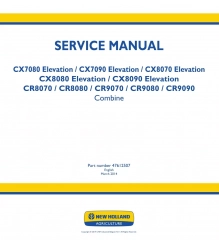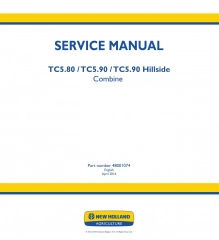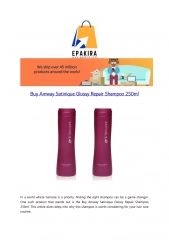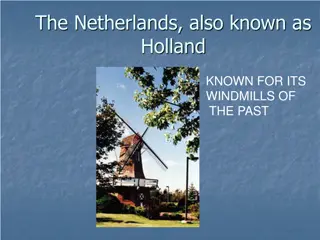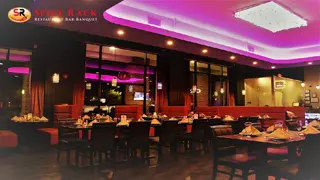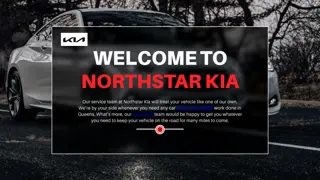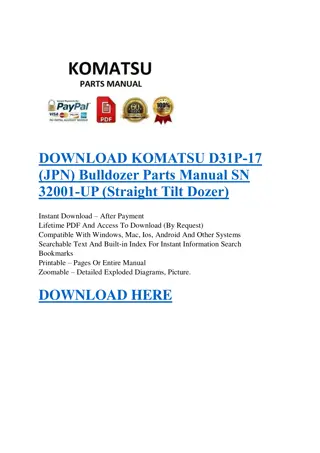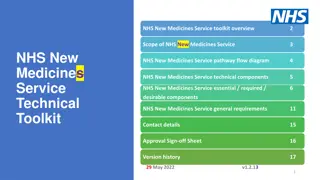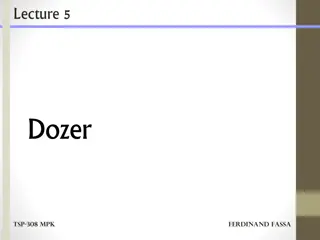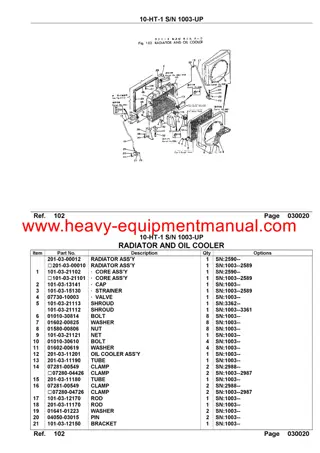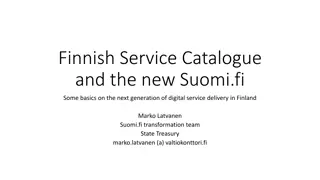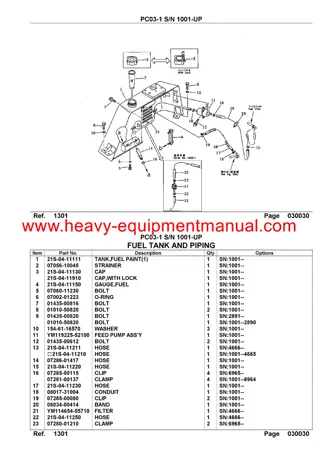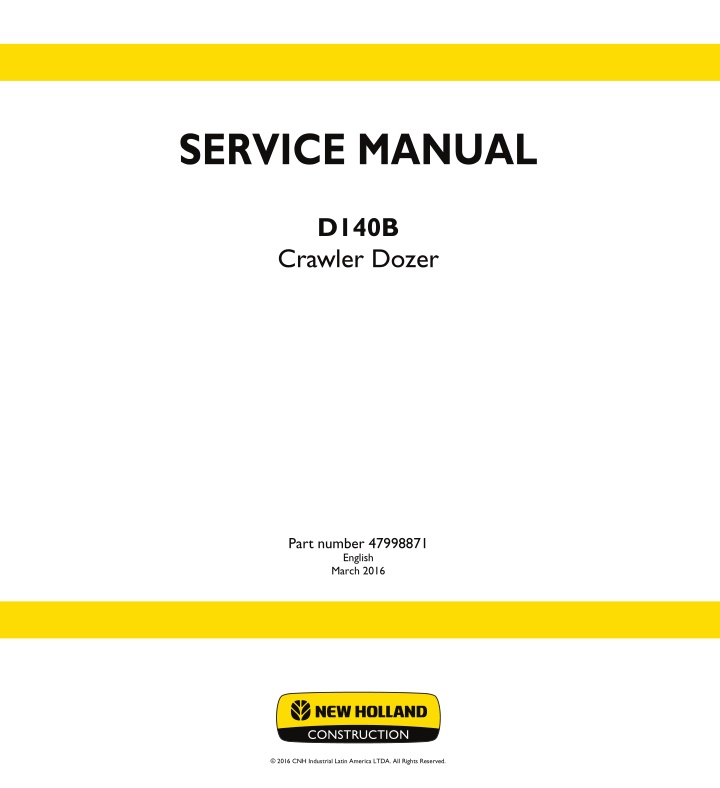
New Holland D140B Crawler Dozer Service Repair Manual Instant Download
New Holland D140B Crawler Dozer Service Repair Manual Instant Download
Download Presentation

Please find below an Image/Link to download the presentation.
The content on the website is provided AS IS for your information and personal use only. It may not be sold, licensed, or shared on other websites without obtaining consent from the author. If you encounter any issues during the download, it is possible that the publisher has removed the file from their server.
You are allowed to download the files provided on this website for personal or commercial use, subject to the condition that they are used lawfully. All files are the property of their respective owners.
The content on the website is provided AS IS for your information and personal use only. It may not be sold, licensed, or shared on other websites without obtaining consent from the author.
E N D
Presentation Transcript
SERVICE MANUAL SERVICE MANUAL D140B Crawler Dozer D140B Crawler Dozer 1/1 Part number 47998871 English March 2016 Part number 47998871 2016 CNH Industrial Latin America LTDA. All Rights Reserved.
SERVICE MANUAL D140B XLT PAT [HBZN140BPDAC00286 - ] 47998871 15/03/2016 EN
Link Product / Engine Product Market Product Latin America Engine D140B XLT PAT [HBZN140BP- DAC00286 - ] F4HE9684K*J100 47998871 15/03/2016
https://www.ebooklibonline.com Hello dear friend! Thank you very much for reading. Enter the link into your browser. The full manual is available for immediate download. https://www.ebooklibonline.com
Contents INTRODUCTION Engine....................................................................................... 10 [10.001] Engine and crankcase ............................................................. 10.1 [10.400] Engine cooling system ............................................................. 10.2 [10.310] Aftercooler.......................................................................... 10.3 [10.304] Engine lubrication system.......................................................... 10.4 Rear axle system........................................................................ 27 [27.120] Planetary and final drives .......................................................... 27.1 [27.126] Spur gear and final drives.......................................................... 27.2 Hydrostatic drive......................................................................... 29 [29.100] Transmission and steering hydrostatic control..................................... 29.1 [29.202] Hydrostatic transmission ........................................................... 29.2 Brakes and controls .................................................................... 33 [33.202] Hydraulic service brakes ........................................................... 33.1 Hydraulic systems....................................................................... 35 [35.000] Hydraulic systems.................................................................. 35.1 [35.104] Fixed displacement pump.......................................................... 35.2 [35.310] Distributor and lines................................................................ 35.3 [35.350] Safety and main relief valves ...................................................... 35.4 [35.741] Dozer blade cylinders .............................................................. 35.5 [35.742] Ripper hydraulic system............................................................ 35.6 Tracks and track suspension........................................................ 48 [48.130] Track frame and driving wheels.................................................... 48.1 [48.110] Front suspension................................................................... 48.2 [48.100] Tracks .............................................................................. 48.3 [48.134] Track tension units ................................................................. 48.4 47998871 15/03/2016
[48.138] Track rollers ........................................................................ 48.5 Cab climate control..................................................................... 50 [50.100] Heating............................................................................. 50.1 [50.200] Air conditioning..................................................................... 50.2 Electrical systems....................................................................... 55 [55.013] Engine oil system .................................................................. 55.1 [55.000] Electrical system ................................................................... 55.2 [55.100] Harnesses and connectors......................................................... 55.3 [55.525] Cab engine controls................................................................ 55.4 [55.015] Engine control system.............................................................. 55.5 [55.201] Engine starting system............................................................. 55.6 [55.301] Alternator........................................................................... 55.7 [55.302] Battery.............................................................................. 55.8 [55.202] Cold start aid ....................................................................... 55.9 [55.010] Fuel injection system............................................................. 55.10 [55.012] Engine cooling system ........................................................... 55.11 [55.019] Hydrostatic drive control system ................................................. 55.12 [55.050] Heating, Ventilation, and Air-Conditioning (HVAC) control system............... 55.13 [55.408] Warning indicators, alarms, and instruments .................................... 55.14 [55.101] Chassis harness ................................................................. 55.15 [55.014] Engine intake and exhaust system............................................... 55.16 [55.DTC] FAULT CODES.................................................................. 55.17 Dozer blade and arm................................................................... 86 [86.110] Dozer blade ........................................................................ 86.1 Tools......................................................................................... 89 [89.128] Ripper assembly ................................................................... 89.1 Platform, cab, bodywork, and decals............................................. 90 [90.150] Cab................................................................................. 90.1 47998871 15/03/2016
[90.114] Operator protections ............................................................... 90.2 [90.124] Pneumatically-adjusted operator seat.............................................. 90.3 47998871 15/03/2016
INTRODUCTION 47998871 15/03/2016 1
INTRODUCTION Foreword - Important notice regarding equipment servicing All repair and maintenance work listed in this manual must be carried out only by qualified dealership personnel, strictly complying with the instructions given, and using, whenever possible, the special tools. Anyone who performs repair and maintenance operations without complying with the procedures provided herein shall be responsible for any subsequent damages. The manufacturer and all the organizations of its distribution chain, including - without limitation - national, regional, or local dealers, reject any responsibility for damages caused by parts and/or components not approved by the manu- facturer, including those used for the servicing or repair of the product manufactured or marketed by the manufacturer. In any case, no warranty is given or attributed on the product manufactured or marketed by the manufacturer in case of damages caused by parts and/or components not approved by the manufacturer. The manufacturer reserves the right to make improvements in design and changes in specifications at any time without notice and without incurring any obligation to install them on units previously sold. Specifications, descriptions, and illustrative material herein are as accurate as known at time of publication but are subject to change without notice. In case of questions, refer to your NEW HOLLAND CONSTRUCTION Sales and Service Networks. 47998871 15/03/2016 3
INTRODUCTION Foreword - How to use and navigate through this manual This manual has been produced by a new technical information system. This new system is designed to deliver technical information electronically through web delivery (eTIM), DVD, and paper manuals. A coding system called SAP has been developed to link the technical information to other Product Support functions, e.g., Warranty. Technical information is written to support the maintenance and service of the functions or systems on a customer's machine. When a customer has a concern on their machine it is usually because a function or system on their ma- chine is not working at all, is not working efficiently, or is not responding correctly to their commands. When you refer to the technical information in this manual to resolve that customer's concern, you will find all the information classified using the SAP coding, according to the functions or systems on that machine. Once you have located the technical information for that function or system, you will then find all the mechanical, electrical or hydraulic devices, compo- nents, assemblies, and sub assemblies for that function or system. You will also find all the types of information that have been written for that function or system: the technical data (specifications), the functional data (how it works), the diagnostic data (fault codes and troubleshooting), and the service data (remove, install adjust, etc.). By integrating SAP coding into technical information, you will be able to search and retrieve just the right piece of technical information you need to resolve that customer's concern on his machine. This is made possible by attaching 3 categories to each piece of technical information during the authoring process. The first category is the Location, the second category is the Information Type and the third category is the Product: LOCATION - the component or function on the machine, that the piece of technical information is going to describe (e.g., Fuel tank). INFORMATION TYPE - the piece of technical information that has been written for a particular component or func- tion on the machine (e.g., Capacity would be a type of Technical Data describing the amount of fuel held by the fuel tank). PRODUCT - the model for which the piece of technical information is written. Every piece of technical information will have those three categories attached to it. You will be able to use any combi- nation of those categories to find the right piece of technical information you need to resolve that customer's concern on their machine. That information could be: the procedure for how to remove the cylinder head a table of specifications for a hydraulic pump a fault code a troubleshooting table a special tool 47998871 15/03/2016 4
INTRODUCTION Safety rules - Ecology and the environment Soil, air, and water quality is important for all industries and life in general. When legislation does not yet rule the treatment of some of the substances that advanced technology requires, sound judgment should govern the use and disposal of products of a chemical and petrochemical nature. Familiarize yourself with the relative legislation applicable to your country, and make sure that you understand this legislation. Where no legislation exists, obtain information from suppliers of oils, filters, batteries, fuels, anti-freeze, cleaning agents, etc., with regard to the effect of these substances on man and nature and how to safely store, use, and dispose of these substances. Helpful hints Avoid the use of cans or other inappropriate pressurized fuel delivery systems to fill tanks. Such delivery systems may cause considerable spillage. In general, avoid skin contact with all fuels, oils, acids, solvents, etc. Most of these products contain substances that may be harmful to your health. Modern oils contain additives. Do not burn contaminated fuels and or waste oils in ordinary heating systems. Avoid spillage when you drain fluids such as used engine coolant mixtures, engine oil, hydraulic fluid, brake fluid, etc. Do not mix drained brake fluids or fuels with lubricants. Store all drained fluids safely until you can dispose of the fluids in a proper way that complies with all local legislation and available resources. Do not allow coolant mixtures to get into the soil. Collect and dispose of coolant mixtures properly. The air-conditioning system contains gases that should not be released into the atmosphere. Consult an air-condi- tioning specialist or use a special extractor to recharge the system properly. Repair any leaks or defects in the engine cooling system or hydraulic system immediately. Do not increase the pressure in a pressurized circuit as this may lead to a component failure. Protect hoses during welding. Penetrating weld splatter may burn a hole or weaken hoses, allowing the loss of oils, coolant, etc. Battery recycling Batteries and electric accumulators contain several substances that can have a harmful effect on the environment if the batteries are not properly recycled after use. Improper disposal of batteries can contaminate the soil, groundwater, and waterways. NEW HOLLAND CONSTRUCTION strongly recommends that you return all used batteries to a NEW HOLLAND CONSTRUCTION dealer, who will dispose of the used batteries or recycle the used batteries properly. In some countries, this is a legal requirement. Mandatory battery recycling NOTE: The following requirements are mandatory in Brazil. Batteries are made of lead plates and a sulfuric acid solution. Because batteries contain heavy metals such as lead, CONAMA Resolution 401/2008 requires you to return all used batteries to the battery dealer when you replace any batteries. Do not dispose of batteries in your household garbage. Points of sale are obliged to: Accept the return of your used batteries Store the returned batteries in a suitable location Send the returned batteries to the battery manufacturer for recycling 47998871 15/03/2016 9
INTRODUCTION Safety rules Personal safety This is the safety alert symbol. It is used to alert you to potential personal injury hazards. Obey all safety messages that follow this symbol to avoid possible death or injury. Throughout this manual and on machine safety signs, you will find the signal words DANGER, WARNING, and CAU- TION followed by special instructions. These precautions are intended for the personal safety of you and those working with you. Read and understand all the safety messages in this manual before you operate or service the machine. DANGER indicates a hazardous situation that, if not avoided, will result in death or serious injury. The color associated with DANGER is RED. WARNING indicates a hazardous situation that, if not avoided, could result in death or serious injury. The color associated with WARNING is ORANGE. CAUTION indicates a hazardous situation that, if not avoided, could result in minor or moderate injury. The color associated with CAUTION is YELLOW. FAILURE TO FOLLOW DANGER, WARNING, AND CAUTION MESSAGES COULD RESULT IN DEATH OR SERIOUS INJURY. Machine safety NOTICE: Notice indicates a situation that, if not avoided, could result in machine damage or property damage. The color associated with Notice is BLUE. Throughout this manual you will find the signal word Notice followed by special instructions to prevent machine dam- age or property damage. The word Notice is used to address practices not related to personal safety. Information NOTE: Note indicates additional information that clarifies steps, procedures, or other information in this manual. Throughout this manual you will find the word Note followed by additional information about a step, procedure, or other information in the manual. The word Note is not intended to address personal safety or property damage. 47998871 15/03/2016 10
SERVICE MANUAL Engine D140B XLT PAT [HBZN140BPDAC00286 - ] 47998871 15/03/2016 10
Engine - Engine and crankcase Engine - Remove 1. Remove radiator. NOTE: If the machine is equipped with a brush-type shield, continue to item 2. Otherwise, go to item 3. 2. Install appropriate lifting equipment on the brush-type shield. Remove the two lower bolts and the jam nuts. Remove the two upper bolts and the fixing washers of the brush-type shield. Remove the brush-type shield. 3. Remove the side doors of the engine compartment. 4. Loosen the air filter hose clamps. Remove the hose. Disconnect the electrical connectors from the air re- striction indicator. 1 LAIL11CD1104A0A 5. Loosen the inlet hose clamp of the intake air cooler. 2 LAIL11CD1682A0A 6. Loosen the hose clamp from the intake air cooler lo- cated on the turbocharger outlet. Remove the intake air cooler line. 3 LAIL11CD1683A0A 47998871 15/03/2016 10.1 [10.001] / 12
Engine - Engine and crankcase 7. Loosen the engine inlet hose clamp. 4 LAIL11CD1105A0A 8. Loosen the outlet hose clamp of the intake air cooler. Remove the intake air cooler line. 5 LAIL11CD1684A0A 9. Install lifting equipment on the hood. 10. Remove the two nuts and the washers (2) from the rear of the engine hood. 6 LAIL11CD1106A0A 11. Remove the four bolts (1), the hood mounting bolts (2), and the strap from the radiator (3). 7 LAIL11CD1107A0A 12. Remove the hood, the air filter, and the intake air cooler from the machine. 47998871 15/03/2016 10.1 [10.001] / 13
Engine - Engine and crankcase 13. If the machine is equipped with a heater, loosen the clamps. Disconnect the heater hoses. Cap the end of the hoses to prevent the spillage of coolant. 14. Disconnect the wires from the alternator. 8 LAIL11CD1108A0A 15. Disconnect the battery cable and the wires of the starter motor wiring harness. 9 LAIL11CD1672A0A 16. Discharge the air-conditioning system. See Air con- ditioning - Charging (50.200). Disconnect the clutch electrical connector and the compressor hoses. Plug the ends of the hoses and the fittings. 10 LAIL11CD1685A0A 17. Disconnect the electrical connector of the Engine Control Unit. 11 LAIL11CD1109A0A 47998871 15/03/2016 10.1 [10.001] / 14
Engine - Engine and crankcase 18. Close the fuel valve (1). Disconnect the fuel line from the valve (2) and from the engine (3). 12 LAIL11CD1110A0A 19. Disconnect the ground cable from the extension hous- ing. NOTE: Tilt the cab or ROPS canopy. See Roll Over Pro- tective Structure (ROPS) frame - Tilt (90.114). 20. The wiring harnesses and the hoses of the heater (if equipped) can be pulled into the hydrostatic compart- ment and moved away. 21. Install lifting equipment on the engine. 22. Remove the mounting bolts from the rear of the en- gine. 13 LAIL11CD1111A0A 23. Removethemountingboltfromthefrontoftheengine. 14 LAIL11CD1112A0A 24. Lifttheengineslightly. Movetheengineforward. Slide the drive shaft to disconnect the drive shaft from the hydro pumps until the bulkhead engine is freed. 25. Remove the engine from the machine. 47998871 15/03/2016 10.1 [10.001] / 15
Suggest: If the above button click is invalid. Please download this document first, and then click the above link to download the complete manual. Thank you so much for reading
Engine - Engine and crankcase Engine - Disassemble D140B LA Reconditioning the engine on the workbench 1. Remove the drain plug from the crankcase to drain the engine oil. 2. Use the supports to secure the engine to the trestle as follows (work from the left-hand side of the engine). Use a suitable tool to remove the fuel filter (5) from its bracket (1). Disconnect the low pressure lines (2), (3), and (4) from the fuel filter bracket (1). Remove the fuel filter bracket (1) from the engine block. 1 LAIL11CD1407A0A 3. NOTICE: Push the clamp (1), as shown in Fig. 2, to dis- connect the low pressure fuel lines (2), (3), and (4) from the corresponding fittings. After you disconnect the lines, put the clamp (1) back in the position shown in Fig. 2 to prevent the deformation of the clamp. 2 LAIL11CD1408A0A 4. Disconnect the fuel line (1) from the "common rail" and from the high pressure pump (5). Remove the mount- ing bolts (2) to remove the fuel line. NOTICE: When you loosen the fitting (3) of the fuel line (1), use an appropriate wrench so that the fitting (4) of the high pressure pump (5) does not turn. 3 LAIL11CD1409A0A 47998871 15/03/2016 10.1 [10.001] / 16
https://www.ebooklibonline.com Hello dear friend! Thank you very much for reading. Enter the link into your browser. The full manual is available for immediate download. https://www.ebooklibonline.com

